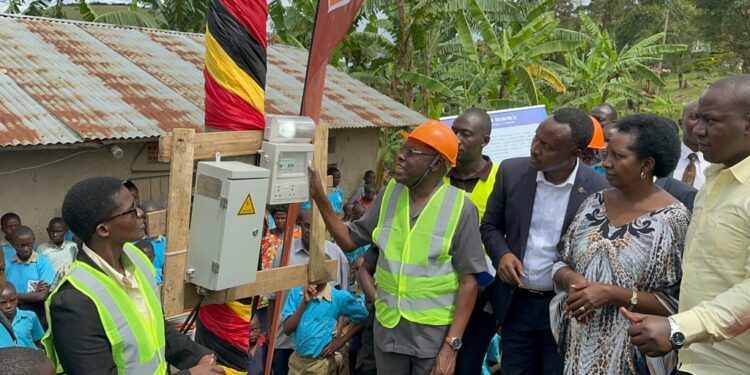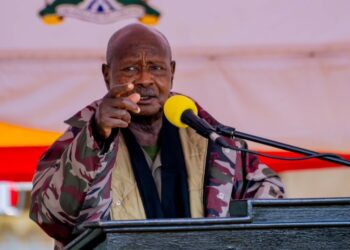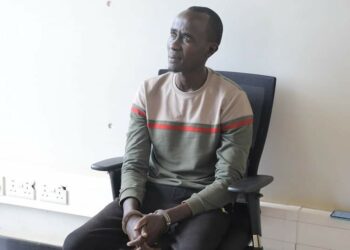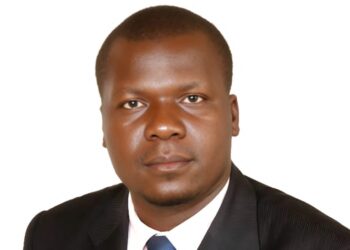The Minister of State for Energy, Okaasai Sidronius Opolot has commissioned the Rural Electrification Programme powerlines in the Rwampara district.
At least 118.327km of distribution power lines (35.449km of MV lines, 82.878km of LV) were constructed in the district, and 25 transformers were installed in the sub-counties of Bugamba, Mwizi I, Mwizi II, and Ndejia, with funding from the Chinese Bank.
Speaking at a commissioning event organized at Kanyantura Primary School in Kibaare, Ndeija Sub County, Minister Okaasai announced that 2,000 free connections would be made to households in the area under the Electricity Access Scale-Up Project (EASP).
He said the electricity schemes commissioned on Wednesday are part of a bigger project in 91 districts. The Project covers 3,449.1km of Medium Voltage (MV), 7,131.61km of Low Voltage (LV) and the installation of 1,926 distribution transformers. The implementation by TBEA Co. Ltd currently stands at 90 per cent and is due for completion within this Financial Year.
The Minister said an additional 105.324km (17.457km of MV and 87.885km of LV), plus 19 transformers, would soon be constructed in Rwampara under the Electricity Access Scale-Up Project (EASP). These will connect the trading centres of Katenga, Nyabikungu, Kagarama, Mikamba, Kabutare, Kaiho, Nyakabungo, Mwere-Nyakinengo, Kayanga, Kinoni, Aksusano, Kijojo, Nuakahanga, and Buteraniro.
“I wish to note that the Government of Uganda continues to prioritize the Energy Sector. Its efforts are evident in the Sustainable Energy Developmental objectives highlighted in the National Development Plan III. H.E., the President, has been at the forefront of ensuring universal access to Ugandans for socio-economic development, especially in rural areas. Access to sustainable energy contributes to a better-quality life, ensures job and wealth creation, and improved living standards, education, and health service delivery, among other benefits,” said Minister.
The minister explained that the presence of modern energy in different communities unlocks access to improved healthcare and education, enhances economic opportunities, and catalyzes the growth of human development indicators. Yet the lack of modern energy services in any given community is a major social and economic development constraint. “Women bear the brunt of energy poverty as they strive to support their families.”
According government had implemented the Electricity Connection Policy (ECP) to address the issue of the affordability of power. But plans were greatly hampered by the COVID-19 pandemic that affected the economy. However, now the government is back on track, and so far has introduced the following stop-gap measures:
In December 2021, the Cooking Tariff of Shs.412 per unit was introduced under the Declining Block Tariff Structure. Under this program, the government intends to lower the cost of electric cooking than the cost of cooking using firewood and charcoal in homes to promote clean cooking.
Another measure is to ease electricity connection for No pole service, whereby in December 2022, the government introduced a subsidy of Shs.250,883 to customers. Now, one can only make a down payment of Shs200,000 to get a connection, and the balance of Shs.270,000 is recovered from every bill payment over eight years.
However, it is important to note that regarding future planned projects, the Ministry of Energy and Mineral Development has a National Electrification Strategy guiding rural electrification programmes. That notwithstanding, community initiatives and requests are often received and considered for supply under new projects. The minister nevertheless encouraged communities that have received powerlines to use electricity productively.
“The challenge often after electricity has been commissioned is how to use it productively. We hope you have wired your houses and are ready to connect and use the electricity. I request that we continue to work together to support Government projects throughout their implementation. Additionally, I encourage the communities to use this electricity productively,” he said.
The Rwampara County Member of Parliament, Amos Kankunda encouraged his people to use the powerline to develop their communities and families.
“You are the first Minister of Energy to visit this area in Rwampara, and my people are delighted to see you. The people here will use the power you have brought here to generate income for their homes. I also encourage you as your representative to use this power to transform our communities and families.”
Meanwhile, under the Electricity Access Scale-Up (EASP) Project commencing this year, another 105.324km (17.457km of MV and 87.885km of LV) will be constructed in Rwampara, with 19 transformers. These will connect the trading centres of Katenga, Nyabikungu, Kagarama, Mikamba, Kabutare, Kaiho, Nyakabungo, Mwere-Nyakinengo, Kayanga, Kinoni, Aksusano, Kijojo, Nuakahanga, and Buteraniro.
Additionally, the Government also plans to extend power to more areas within the Rwampara district using other funding sources. Additional transformers are scheduled for installation in Kahuro, Kijojo A, Nyakahanga, Ndeija, Nyindo and Katenga, Nyabikungu, Mikamba, Kyabanyoro / Ruzinga, Kagarama, Ruagarama, and Kaboobo Cell.
Do you have a story in your community or an opinion to share with us: Email us at editorial@watchdoguganda.com













